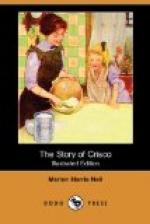Frying
Frying may be looked on as a derivative of broiling, and passes by easy stages, from broiling on a slightly greased metal plate, or sauteing in a shallow pan in a small quantity of Crisco, to cooking by actual immersion into a bath of hot fat. In a house where small and delicately made dishes are in demand, and where variety in the re-dressing of cold meats has to be studied, this frying in deep fat is one of the cook’s most needed accomplishments. Though exceedingly easy to do well, it is also exceedingly easy to do badly.
Deep fat frying, which means submerging the food in the fat, is far superior to shallow or saute frying, and can be done most economically with Crisco. Little is absorbed by the foods, and the Crisco does not take up the odor or flavor of the food which is fried in it. This characteristic makes it possible to use Crisco for frying one article of food after another.
Use plenty of Crisco for frying. The temperature of the hot Crisco then will be but little lowered when the food is added. There is little absorption and what is left may be used for all frying, merely by straining out food particles after each frying.
Sufficient Crisco should be put into the pan to fill it about two-thirds full. From two to three pounds for a pan eight inches in diameter will not be too much. Into this pan or kettle a wire “frying-basket” should fit quite loosely, the basket measuring quite an inch less across the top than the pan.
Let Crisco get hot gradually in the pan. Do not put into an already hot container. No fat should be treated in this manner.
Do Not Wait for Crisco to Smoke
Heat Crisco until a crumb of bread becomes a golden brown in
60 seconds for raw dough mixtures, as crullers, fritters, etc.
40 seconds for cooked mixtures, as croquettes, codfish balls, etc.
20 seconds for French fried potatoes.
Seconds may be counted thus: one hundred and one, one hundred and two, etc.
The fat may be tested also by dropping into it a little piece of the article to be cooked. When it rises to the top, bubbles vigorously and browns quickly, the fat is hot enough.
When prepared, the foods must be placed in the basket, not too many at a time or too close together, and then lowered gently into the fat. They generally will sink to the bottom for a minute or two, and only float when they have begun to brown. When a bright golden brown, take up the basket and let the fried things drain in it, over the hot fat, for a few seconds. Then take them out gently one by one, and lay them on a sheet of brown or kitchen paper.
The draining over the pan is one of the principal things to attend to; if this be neglected, the fat will cling about the fried things, making them both look and taste greasy, whereas if properly drained in the basket to begin with, they will afterwards scarcely mark the paper. When, as is sometimes the case, no frying basket is used, each thing fried should be drained between a spoon and the edge of the pan.




